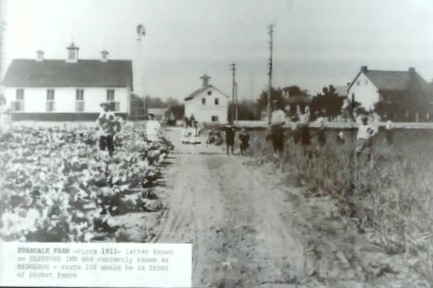The Farms of Col. James Young
By Ruth Shireman and Nancy Avolese
James Young was the son of Peter and Sophia Young, born at Swatara Hill, PA on July 25, 1820. His father, Peter was born on November 13, 1781 and was a hotel keeper most of his life. James started assisting his father in the hotel business when he was 15 years old. He saved his money and by 1839, he purchased a canal boat, which he ran for one year between Hollidaysburg and Philadelphia. In 1840, he established a lumber yard in Middletown and added a coal business which endured for over 26 years. He also furnished supplies to the Pennsylvania Railroad Company and was the purchasing agent for the Northern Central and Pennsylvania Railroad Company for several years.
On June 3, 1843, James Young married Elizabeth Ann Redsecker when he was 22 years old. Together they had eight children (Redsecker I., Delanson James, Catherine, Sarah H., James Samuel, George W., Simon Cameron Young, and Henry Peter)
Around 1859, James Young purchased a limestone quarry at Leaman Place in Lancaster County. He owned a large amount of real estate in Middletown and elsewhere, including the Washington Hotel, an opera house, a store, and other homes and farmland. He took an active interest in local affairs and was identified with various local institutions and enterprises. He was president of the American Tube and Iron Company, President of the Cameron Furnace, Director of the Commonwealth Guarantee, Trust and Safe Deposit Company of Harrisburg. He was on the Board of Directors of the Farmer’s Bank on South Union Street (now the Brownstone Restaurant). He was a member of the State Board of Agriculture of Pennsylvania, that of which he had been appointed by the Governor. He was a regular attendant and supporter of St. Peter’s Lutheran Church in Middletown (His maternal grandfather, David Ettelin, traveled to ask the King of England to help raise funds to build St. Peter’s Kierch).
The Young farms extended along the turnpike road for 2 ½ miles and along the line of the Pennsylvania Railroad. The same characteristics were evident in all his farms. Not only were the buildings beautiful and well-maintained but the methods and systems used, neatness and order, care, thrift, and hard work were superbly managed and in highest state of cultivation. James Young added farm after farm, one at a time, until he owned over 1400 acres. Besides agriculture crops (wheat, corn, oats, hay, tobacco, and other vegetables), he raised both dairy (Alderney and Jersey) and beef cattle. He raised pigs, (Chester Whites, and Berkshires), purebred Southdown sheep and Plymouth Rock hens. He contrived a unique “steam chest” method of preparing food/mash for his livestock. Windmills were attached to wells and used together with large storage tanks for their water supply. Very little commercial fertilizer was ever used as he used his animals manure to fertilize his fields. He supervised all the work on the farms, making daily visits, with the help of son James. His farms were known as “The Pride of Dauphin County” and he had many visitors to his farms from Presidents, Governors, and other distinguished professional men from almost every walk of life. There was no other tract of land over 1400 acres under one ownership at that time that could compare with Young's farms.
In 1893, the Harrisburg Daily Independent newspaper indicated that large photographs of the James Young farms would be sent to Chicago to be shown at the World's fair.
James Young died at the age of 74 the morning of May 4, 1895 from complications of a head injury he had sustained on May 2, 1895 as he was thrown from his buggy while crossing the P. & R. railroad track.
He had twelve farms and additional land. Eleven of his farms are depicted on below. Youngsport, a tobacco barn and buildings was considered the twelfth farm but there is no drawing.










Keystone Farm

Evandale Farm

This poem was written by B. J. Talbott, a solider stationed at Camp Meade. It appeared in the Harrisburg Telegraph Newspaper on August 29, 1898.

A photo of Evandale Farm around 1911 - courtesy of Sam Seltzer.
Sources:
The Chronicles of Middletown, PA, C. H. Hutchinson
https//archive.org/details/chroniclesofmidd00hutc_0
http://www.middletownpadauphincounty.com/col-james-young.php
Young/Wealands in Middletown, PA 2/12/2001.
Harrisburg Telegraph, August 29, 1898.
